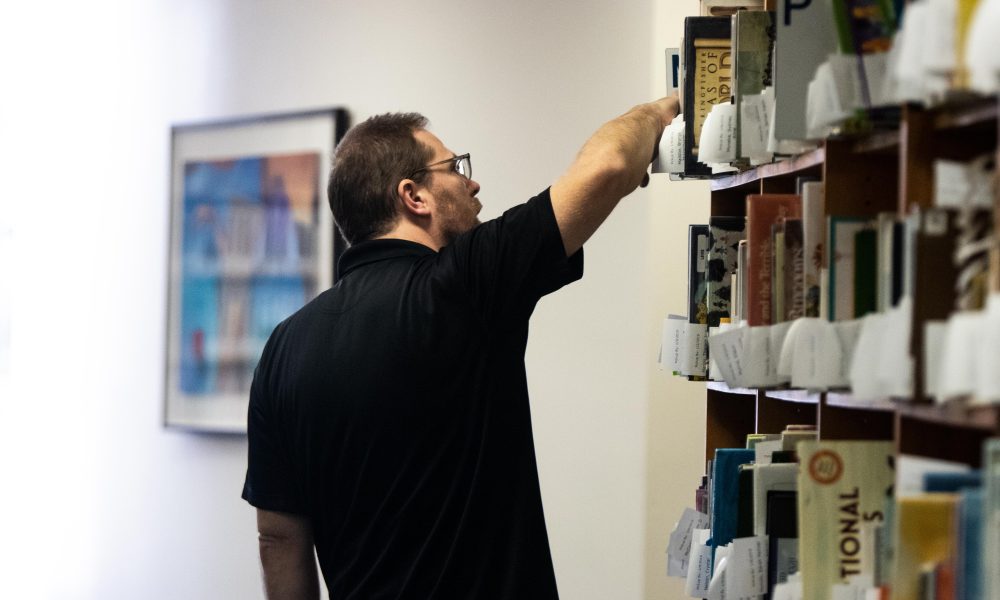 A man at Salem Public Library in December. Officials with the Chemeketa Cooperative Regional Library System said Monday that the Salem library and many others it works with have been miscounting their print materials. (Caleb Wolf/Special to Salem Reporter)
A man at Salem Public Library in December. Officials with the Chemeketa Cooperative Regional Library System said Monday that the Salem library and many others it works with have been miscounting their print materials. (Caleb Wolf/Special to Salem Reporter)
Data used by Salem Public Library to justify a rigorous review of its books was flawed, recent interviews have established.
Officials at the Chemeketa Cooperative Regional Library System say the Salem Public Library inaccurately included microfilm, magazines, newspapers and other items last year when it submitted its count of “print materials” to the State Library of Oregon. Libraries send such data every year.
The result is that the count of 329,012 “print materials” stands closer to 278,000, according to John Goodyear, executive director of the system, which counts collections on behalf of libraries in the region.
Goodyear said the system provides the 17 libraries in its membership a raw spreadsheet annually that the libraries then use to report data to state.
“We provide a spreadsheet to libraries that goes into videos, audio, all kinds of other things (that libraries offer),” he said. “We don’t package these numbers in any form. We feed them to the libraries and they put them into an online form that recreates a report to the state.”
Goodyear said it appears the Salem library added similar categories together that they shouldn’t. He called it a misunderstanding that most of its members have been making.
The revelation that the library has about 45,000 fewer books than previously reported comes as the library battles perceptions its review will eliminate too many books and the library would no longer serve its mission for Salem residents.
Jim Scheppke, a former director of the State Library of Oregon and the most vocal opponent to the review, discovered the flaw. He said sometime in January he suspected a data problem, but he didn’t know what.
“I had reason to believe there was an overcount,” he said. Scheppke’s wife is a former librarian at the Salem library.
Scheppke raised the overcount question with employees at the state library. He said he knew they wanted to ensure the data was accurate because they are required to report to the federal government. He said a staffer there then told him it was possible books were getting counted alongside magazines and other items.
The overcount was then confirmed by Goodyear. He told Salem Reporter that the processes conducted by the system and its members had been in place for years. He said the state library never found fault in the past.
“Several years ago, (state library staff) came to our meetings and talked about how to do these reports. It is a lot of information with a lot of interpretations,” he said.
He added that data requested by the state library is not clear-cut. The state library defines “print materials” as non-serialized books in print. Libraries would not add magazines and newspapers with books, yet bound government documents, sheet music and maps could be counted.
City Librarian Sarah Strahl said the new numbers won’t change the library’s review. She said the total size doesn’t tell the whole story of why the library collections need pruning.
“Of course we’re going to want to look at that context,” she said. But, she added, “this project doesn’t have anything to do with the size of the collection, one way or another.”
At 278,000 print materials, the Salem library would retain the fourth largest such collection in Oregon. Third is the Eugene Public Library, serving 4,000 more people, with 99,000 more print materials, according to preliminary state data.
The review began late last year. In September, the library enacted a “collection development policy” to ensure its collections — everything from books to DVDs to ukuleles — are up-to-date, in good condition and are what library users want.
After the policy was approved by the Salem City Council, the library started the review. Library leaders used the state library data in part to conclude the local library was bigger than others across the country with similar budgets and populations served.
Scheppke, who has argued the library has removed tens of thousands of books already in the last five years, said the data flaw undermines those reports.
“That means their analysis is no good,” he said.
Strahl contends the review is more driven by internal reports that show checkout rates, date a book was last checked out, numbers of copies, among other things. She said the total number is “a snapshot.”
“The evaluation looks at every individual item, if it is covered in marker or if there’s a new, better edition,” she said. “That (data) doesn’t play into this part of the work.”
The review has been on pause since December. It was scheduled to start again in January, but the library’s nine-member advisory board voted to delay another month following a contentious public meeting.
The Library Advisory Board meets again Feb. 13.
Have a tip? Contact reporter Troy Brynelson at 503-575-9930, [email protected] or @TroyWB.









